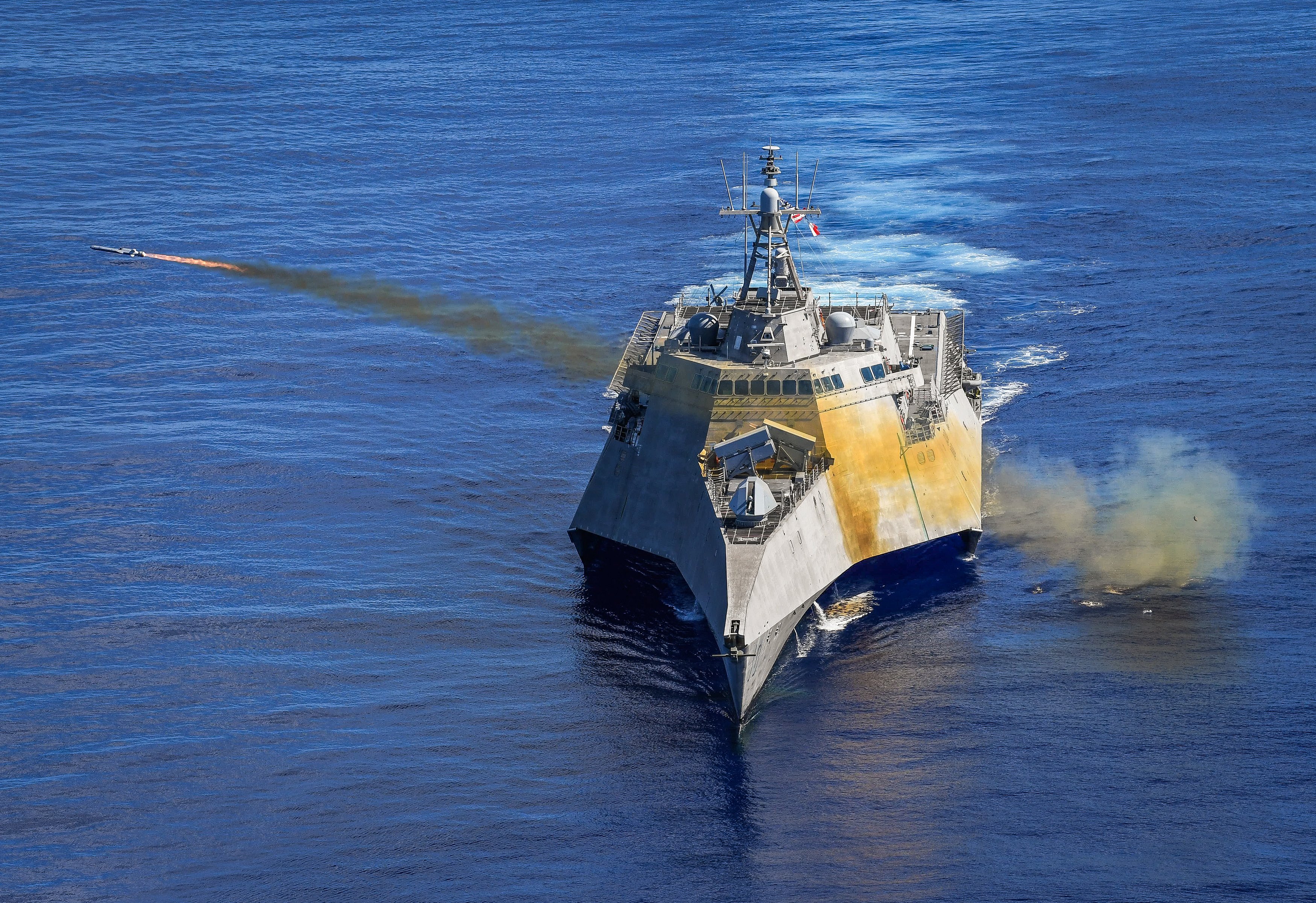
The Chinese military sees the Littoral Combat Ship armed with anti-ship missiles as a key element of a U.S. distributed maritime force in the Western Pacific, according to a translation of a 2020 Chinese government research paper on the U.S. Navy’s distributed lethality concept reviewed by USNI News.
Chinese researchers “compared the littoral combat ship (LCS) with other surface combatants, arguing that the former’s modularity, cheap price, high speed, and other characteristics enable it to become a powerful tool in future distributed lethality tactics,” reads the “The U.S. Navy’s Distributed Lethality Implementation Method” paper from the Marine Design & Research Institute of China (MARIC). MARIC is the central research and development arm for China’s shipbuilding sector.
In particular, the speed at which the U.S. incorporated a test of a Harpoon missile in 2016 on an Independence-class LCS got Chinese attention.
“The results showed that with simple transformation the LCS could also possess some anti-ship capabilities,” reads the paper.
“Modular weapons can reduce ship construction costs while weapons manufactured with the same interface standard can be easily installed on ships that meet this standard. This is extremely conducive to boosting the ship’s overall capabilities, while ease of maintenance and ability for rapid retrofitting are greatly enhanced.”
There are other signs the Chinese military is interested in the LCS concept. The U.S. restarted deploying the Independence-class ships to the Western Pacific starting in 2019 after an almost two-year pause. Since their return, the Indys, most with the capacity to field Naval Strike Missiles, have drawn more scrutiny from the People’s Liberation Army Navy.
While the ships were operating in the South China Sea, the LCS drew three People’s Liberation Army Navy (PLAN) ships to monitor their operations, while an Arleigh Burke guided-missile destroyer typically draws a single Chinese warship to tail it, several Navy officials have told USNI News.
Earlier this year, former U.S. 7th Fleet commander Vice Adm. Bill Merz said the addition of the NSM on the Independence-class LCS would complicate the Chinese calculus in the region.
“When I think about what adversaries have to think about – now it’s not just one particular focus area; now they’ve got to look across the entire theater – and that challenges a staff, that challenges their capabilities. I think it was a huge win, and we’re just seeing the start of that, what multiple LCS in theater can do,” he said.
The Chinese are developing their own version of the Independence-class LCS.
Beyond the LCS, the paper acknowledged that more U.S. surface ships with more anti-ship missiles operating in small surface action groups, rather than larger formations like carrier strike groups or amphibious expeditionary strike groups, would complicate Chinese operations in the Pacific.
“The miniaturization of USN formations is not simply a change in the composition of the formations. Rather, it is an effort to create fully balanced combat forces by integrating platform capabilities, to leverage widely distributed and dispersed combat operations to lower the probability of being detected by [enemy information, surveillance and reconnaissance systems]. Using large numbers of small formations can also create more combat possibilities, generating a full range of threats to the opponent and placing enormous pressure on the opponent’s ISR systems,” reads the paper.
The Chinese answer to the distributed fleet is an investment in improved sensors and maritime awareness and a more robust wargaming program that would train an artificial intelligence battle management aid that could outperform a military commander faced with the distributed force.
“Distributed lethality is an attempt by the U.S. in intelligent warfare, and AI confrontation is also a revolutionary change in future warfare. Therefore, it is necessary to assist command on the battlefield by establishing a wargaming system that can rigorously reflect reality to train an AI system that can deal with distributed lethality,” reads the paper.
For military and civilian applications, Beijing has invested massive amounts into perusing artificial intelligence, according to the final report issued by the U.S. National Security Commission on Artificial Intelligence in March.
“China possesses the might, talent, and ambition to surpass the United States as the world’s leader in AI in the next decade if current trends do not change,” reads the report.
The U.S. is currently researching its own AI-powered battle management aids and is currently in the midst of the wide-ranging Large Scale Exercise to prove out major tenants of its Distributed Maritime Operations concept.





